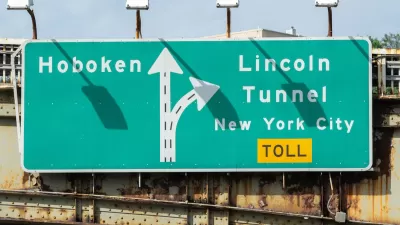How might cordon pricing impact DC drivers and transit users?

In a post in Greater Greater Washington, D. Taylor Reich outlines the results of a study on how road pricing similar to New York City’s new congestion pricing program could work in Washington, D.C.
After building a prototype software program to model changes in transportation behavior, Reich assessed the potential impact of a $5 charge on cars entering one part of the District. According to Reich’s simulation, which includes reinvesting road pricing revenue into public transit, “This particular combination of road pricing and reinvestment would make travel 10% more convenient for lower-income Washingtonians, have a negligible benefit for the average DC resident, and make travel 2% less convenient for the average resident of the greater metro area.”
The model also indicates there would be a 10 percent drop in driving in D.C. and a three percent drop in the metro area. “This reduction in car travel would bring second-order benefits in emissions, road safety, and noise pollution.”
As Reich notes, “Some people would benefit more, while others would lose out—but on the whole, reinvestment in public transportation would mean a major improvement for lower-income people, especially those in more central areas. Moreover, the reduction in car travel would bring other, indirect benefits for the environment and public health.”
FULL STORY: Road pricing could make transportation in the District more equitable

Manufactured Crisis: Losing the Nation’s Largest Source of Unsubsidized Affordable Housing
Manufactured housing communities have long been an affordable housing option for millions of people living in the U.S., but that affordability is disappearing rapidly. How did we get here?

Americans May Be Stuck — But Why?
Americans are moving a lot less than they once did, and that is a problem. While Yoni Applebaum, in his highly-publicized article Stuck, gets the reasons badly wrong, it's still important to ask: why are we moving so much less than before?

Using Old Oil and Gas Wells for Green Energy Storage
Penn State researchers have found that repurposing abandoned oil and gas wells for geothermal-assisted compressed-air energy storage can boost efficiency, reduce environmental risks, and support clean energy and job transitions.

Updating LA’s Tree Rules Could Bring More Shade to Underserved Neighborhoods
A new USC study finds that relaxing Los Angeles’ outdated tree planting guidelines could significantly expand urban tree canopy and reduce shade disparities in lower-income neighborhoods, though infrastructure investments are also needed.

California's Canal Solar Projects Aim to Conserve Resources and Expand Clean Energy
California’s Project Nexus has begun generating electricity from solar panels installed over irrigation canals, with researchers and state agencies exploring statewide expansion to conserve water and boost clean energy production.

HHS Staff Cuts Gut Energy Assistance Program
The full staff of a federal program that distributes heating and cooling assistance for low-income families was laid off, jeopardizing the program’s operations.
Urban Design for Planners 1: Software Tools
This six-course series explores essential urban design concepts using open source software and equips planners with the tools they need to participate fully in the urban design process.
Planning for Universal Design
Learn the tools for implementing Universal Design in planning regulations.
Heyer Gruel & Associates PA
City of Moreno Valley
Institute for Housing and Urban Development Studies (IHS)
City of Grandview
Harvard GSD Executive Education
Salt Lake City
NYU Wagner Graduate School of Public Service
City of Cambridge, Maryland





























